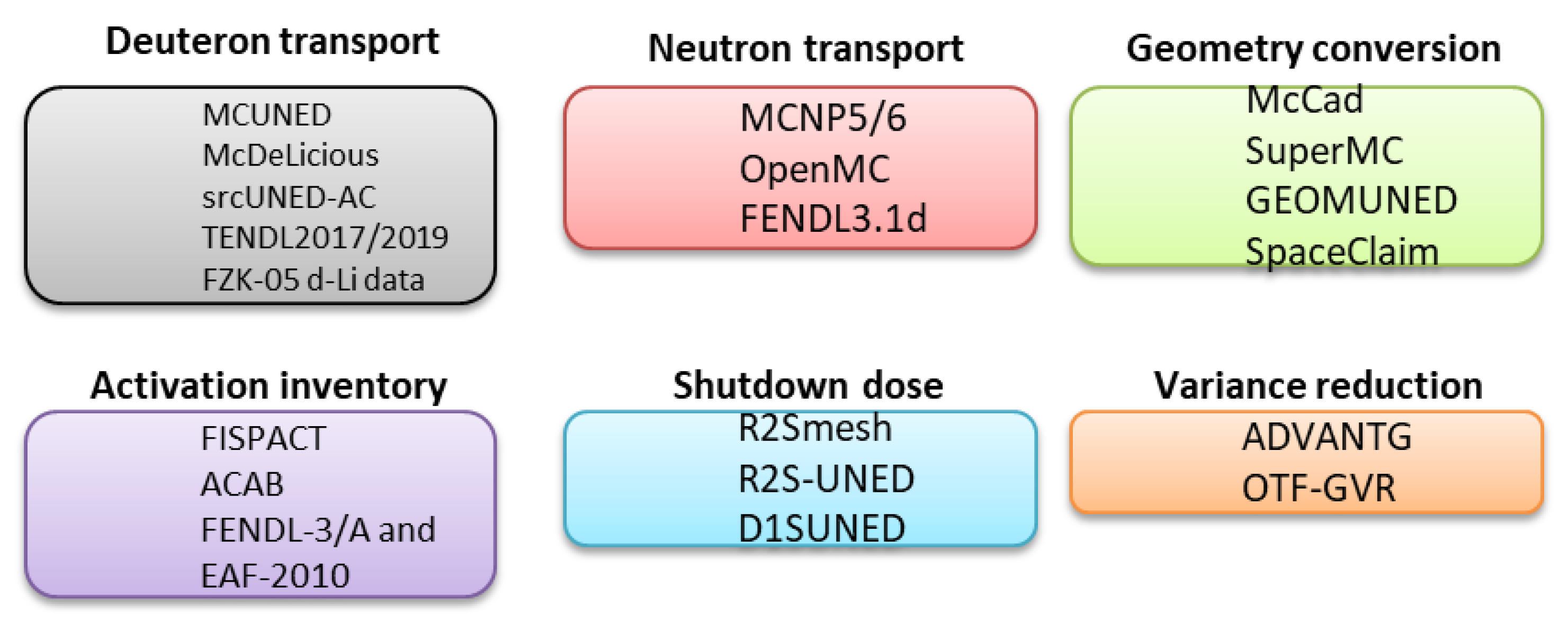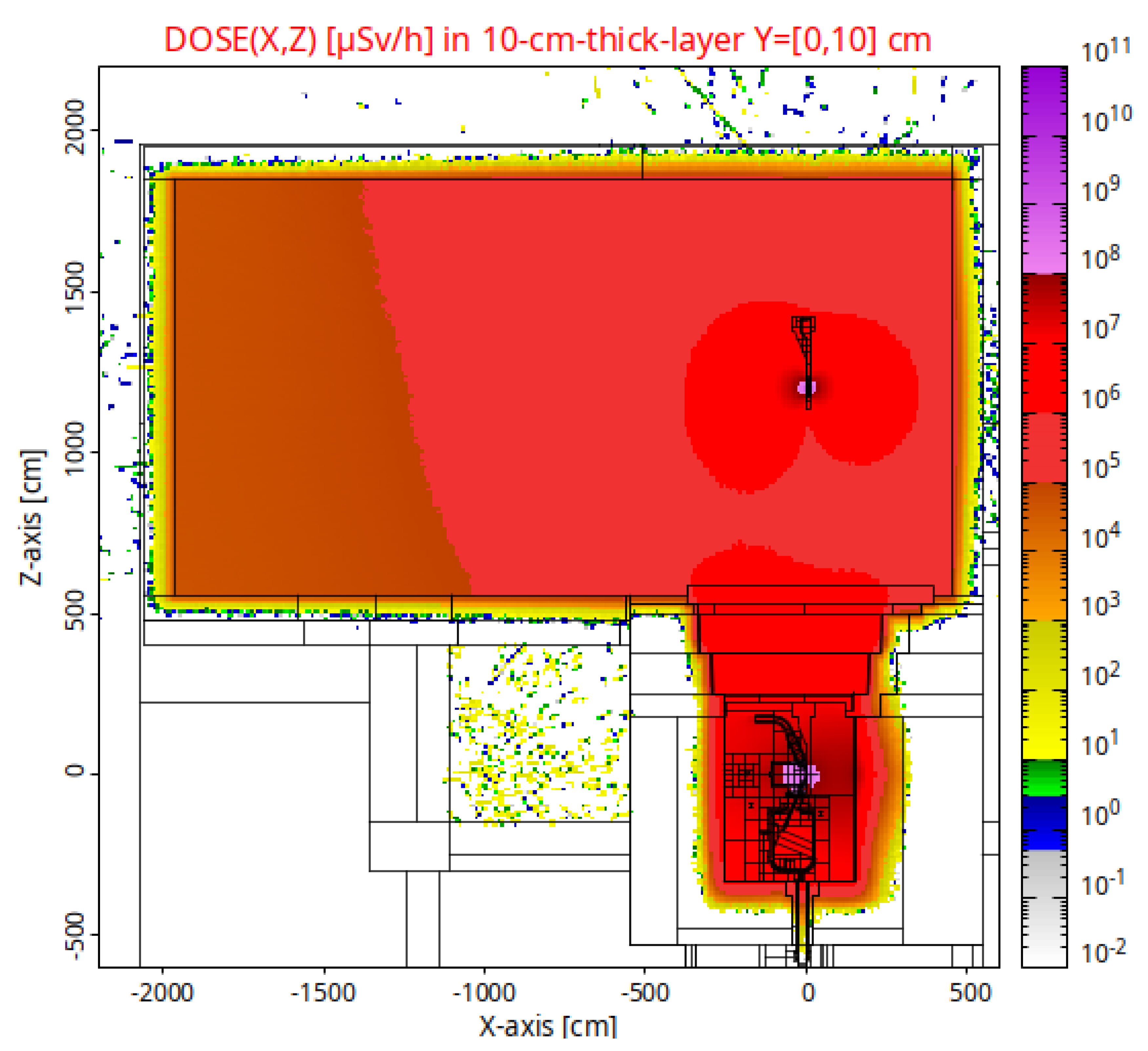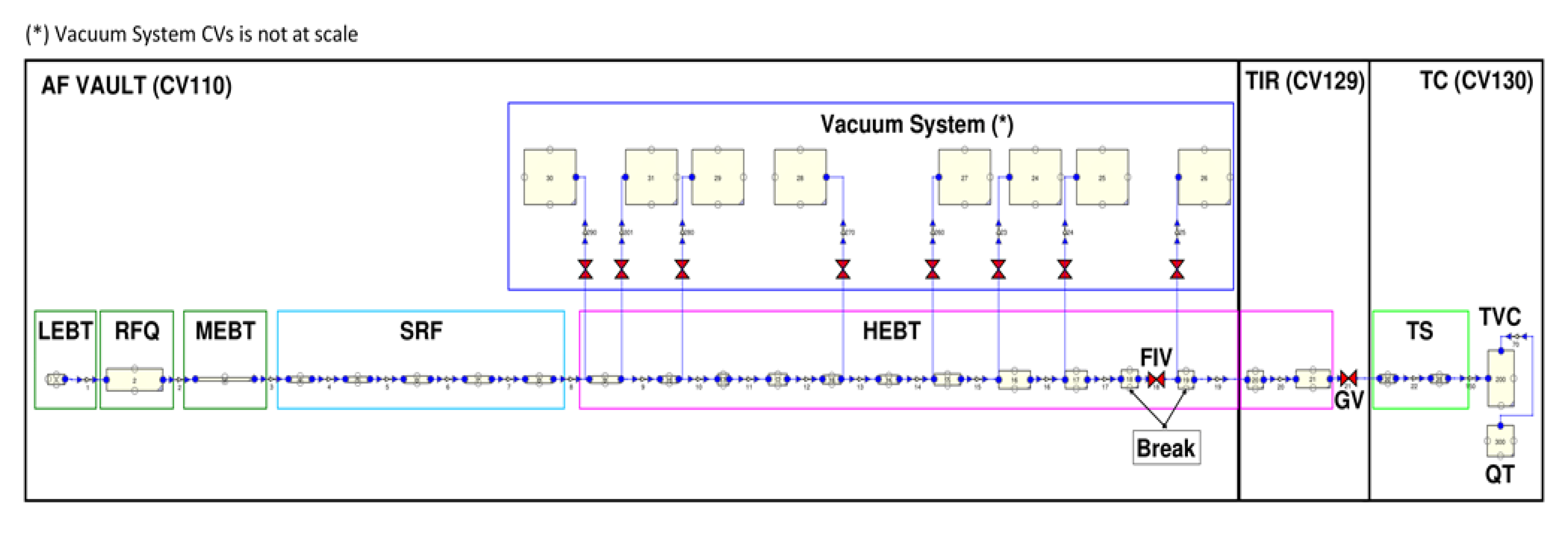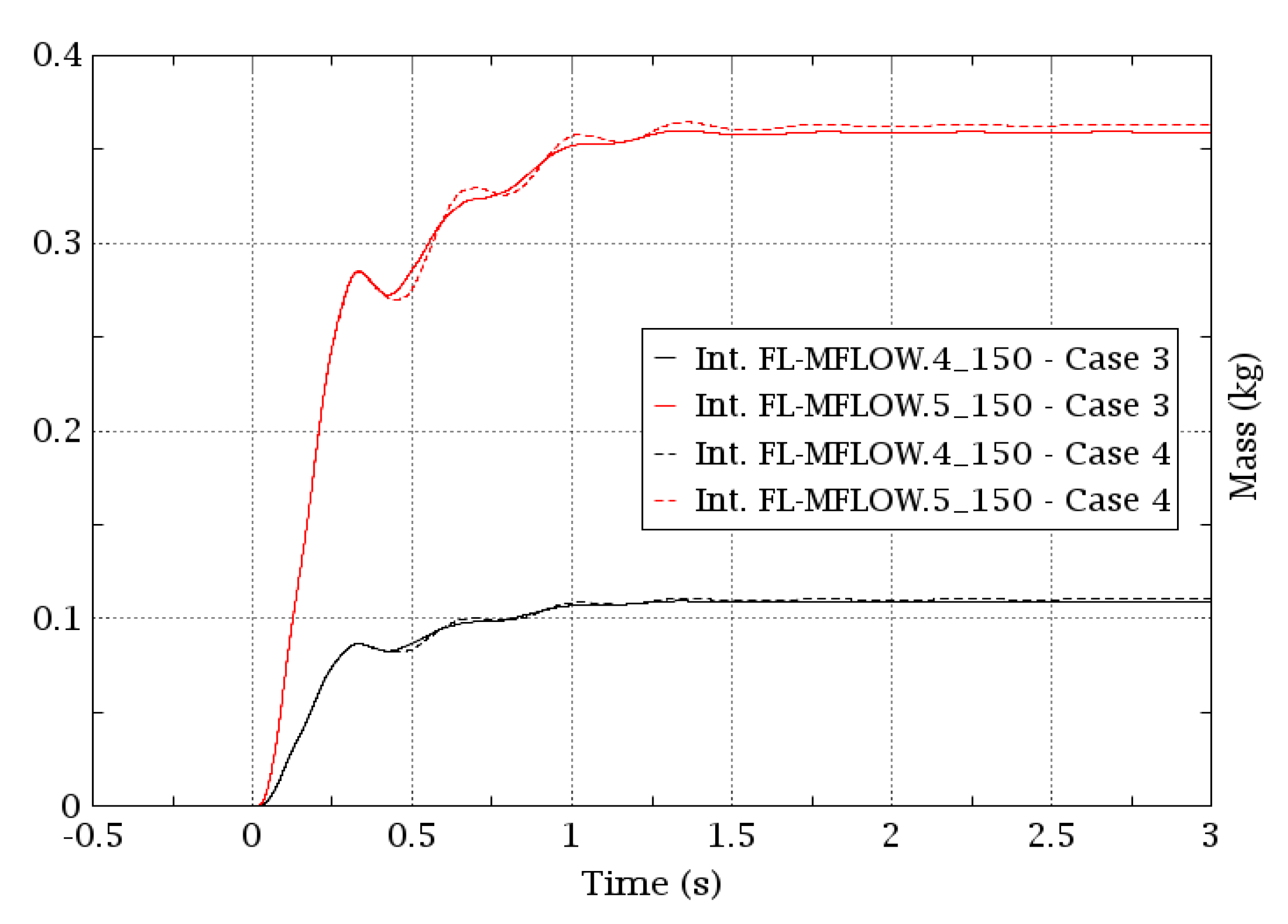Implementation of Safety Aspects in IFMIF-DONES Design
Abstract
1. Introduction
- Accelerator systems (AS). The linear accelerator is divided into the following subsystems: injector, radiofrequency quadrupoles (RFQ) cavities, medium energy beam transport module, superconductor RF cavities along five cryomodules, high-energy beam transport line (with beam scraper and collimator, sources of secondary neutrons), and the beam dump device. RF power systems and ancillaries for water cooling circuits, cryoplant or vacuum are the main ancillary associated systems.
- Lithium systems (LS). These include target systems (the intense source of neutrons), Li loop for heat removal, impurity control system (with traps for activation products and for activated corrosion products), and secondary and tertiary organic oil circuits. There are ancillaries for heating, electric supply, and Li and oil recovery, among others.
- Test systems (TS). These include the test cell (TC), which is a complex system made of several pieces of equipment (a steel liner, upper and lateral shielding blocks), the high flux test module (HFTM, carrying the material samples under irradiation), and TC ancillary systems (for He atmosphere provision as an inerting gas and for equipment purification, He coolant for HFTM, water coolant of the liner).
- Plant systems (PS). A number of important systems are included here, such as remote handling; service gas (argon supply); heating, ventilation, and air conditioning system (HVAC, with particle filtering and room-isolation capabilities); solid, liquid and gaseous radioactive waste treatment systems; and fire protection system, among others.
- Central instrumentation and control systems (CICS). These include the safety control system (safety dedicated), machine protection system (investment protection), and control, data access, and communication (CODAC) system.
- The main building (MB) is a specific large structure with safety functions such as structural confinement, shielding, and provision of infrastructure supporting safety systems.
2. Methodology for Safety Analysis
2.1. Identification of Material at Risk
2.2. Failure Mode Analysis and Top-Down Approaches
3. Radioprotection Aspects at Design Stage
4. List of Reference Scenarios and Safety-Credited Components
- Safety beam shutdown will be achieved at the injector by means of two lines of defense: a safety-credited switch in the magnetron electric supply and insertion of a Faraday cup. Differentiation with machine protection actuators is taken into account (in principle, not safety credited in the analysis of scenarios, but in reality providing an additional safety layer on the basis of high reliability and even faster actuation).
- A fast isolation valve will be placed in HEBT, far enough from high irradiation levels. It will be a component contributing to providing confinement of the TC region, and it will limit air or steam progression to the target from possible breaks in the beam duct.
- High-reliability inertization to prevent Li fires in postulated spills will be provided by the argon supply system and test cell gas inventory control system. When activated under accident conditions, the confinement function will be coincident with the inertization function.
- Two electromagnetic pumps in the Li loop will be implemented in compliance with the redundancy requirement (see further explanations in the deterministic analysis section below).
- A dedicated ‘Personnel Access Safety System’ will prevent the entrance to forbidden access areas or will control access when changed to restricted conditions during maintenance.
- A ‘Plant Safety System’ (subsystem of ‘Safety Control System’) will provide the beam-shutdown function under a number of safety signals implemented in systems involved in the RAS.
- The RAMSES will be a dedicated system to provide safety signals related to radiation detection (also linked to beam shutdown) with credited type detectors such as, for instance, in the case of beam mis-steering events.
- Mechanical codes such as RCC-MRx are systematically revised for application to confinement structures, when possible (pipes, TC liner), to provide robustness in the first line of defense against loss of confinement.
- Detritiation systems based on conversion to tritiated water and absorption by molecular sieves will take the permeated tritium during normal operation (vent detritiation system) and released tritium in case of accident conditions (emergency detritiation system).
5. Support with Probabilistic and Deterministic Analysis
5.1. Probabilistic Analysis
5.2. Deterministic Analysis
- RAS12 and 13, beam duct water ingress, and air ingress. A model of the beam duct has been prepared (Figure 3). Duct wall ruptures and the role of FIV is explored to limit the air or water transport towards the target vacuum chamber that could ignite the lithium. Small amounts are obtained (from 0.2 kg to 0.5 kg air, depending on variation in cases and negligible steam, Figure 4). Further mitigation measures are under analysis to reduce such small impact (i.e., extension of inertized Ar region around FIV).
- RAS1, EMP trip. A model of the Li loop was prepared [5], including prediction of steady-state parameters. Reference calculations were performed for a pump trip in several cases; in one of them the hydraulic power of the pump is reduced to 50%, and it is predicted that the Li layer remains at some 12 m/s, (Figure 5), equivalent to a thick-enough layer to accommodate the beam for an extended period of time before shutdown.
6. Experimental Program in Support of IFMIF-DONES Safety
- IPUL University of Latvia: EMP prototyping and testing, including transients.
- NPI Rez: shielding benchmarking with 35 MeV (p, Be) neutron source.
- RISE Lab, Sweden: Li ignition experiments at small scale.
- CIEMAT, CDTI FUSION-FUTURE Project: LIFIRE facility for Li ignition and mitigation studies, medium scale. Hardware will be received in 2022 [7].
- University of Granada: MUVACAS facility. Investigation of beam duct rupture events, role of valves. Recent bidding.
7. Conclusions
Author Contributions
Funding
Data Availability Statement
Conflicts of Interest
References
- Martín-Fuertes, F.; García, M.E.; Fernández, P.; Cortés, A.; D’Ovidio, G.; Pinna, T.; Porfiri, M.T.; Fischer, U.; Ogando, F.; Mota, F.; et al. Integration of Safety in IFMIF-DONES Design. Safety 2019, 5, 74. [Google Scholar] [CrossRef]
- Ibarra, A.; Arbeiter, F.; Bernardi, D.; Krolas, W.; Cappelli, M.; Fischer, U.; Heidinger, R.; Martin-Fuertes, F.; Micciché, G.; Muñoz, A.; et al. The European approach to the fusion-like neutron source: The IFMIF-DONES project. Nucl. Fusion 2019, 59, 065002. [Google Scholar] [CrossRef]
- Królas, W.; Ibarra, A.; Arbeiter, F.; Arranz, F.; Bernardi, D.; Cappelli, M.; Castellanos, J.; Dézsi, T.; Dzitko, H.; Favuzza, P.; et al. The IFMIF-DONES fusion oriented neutron source: Evolution of the design. Nucl. Fusion 2022, 61, 125002. [Google Scholar] [CrossRef]
- Fischer, U.; Bienkowska, B.; Drozdowicz, K.; Frisoni, M.; Mota, F.; Ogando, F.; Qiu, Y.; Stankunas, G.; Tracz, G. Neutronics of the IFMIF-DONES irradiation facility. Fusion Eng. Des. 2019, 146, 1276–1281. [Google Scholar] [CrossRef]
- D’Ovidio, G.; Martín-Fuertes, F. Accident analysis with MELCOR-fusion code for DONES lithium loop and accelerator. Fusion Eng. Des. 2019, 146, 473–477. [Google Scholar] [CrossRef]
- Louie, D.L.Y.; Humphries, L.L. NSRD-10: Leak Path Factor Guidance Using MELCOR’, SAND2017-3200; Sandia National Lab: Albuquerque, NM, USA, 2017.
- D’Ovidio, G.; Martín-Fuertes, F.; Alegre, D.; Marugán, J.C.; Pitigoi, A.; Sierra, J.; Molla, J. CIEMAT experimental proposal on lithium ignition in support of DONES licensing (LiFIRE facility). Nucl. Mater. Energy 2022, 31, 101177. [Google Scholar] [CrossRef]





| Number of RAS | Key | Description | Risk to Worker (W)/Public (P) |
|---|---|---|---|
| 20 | LS1-1 | Lithium fire event in LLC area | W/P |
| 21 | LS1-2 | Lithium fire event in ICS area | W/P |
| 22 | LS1-3 | Lithium fire event in TC area | W/P |
| 23 | LS1-4 | Lithium fire event in TC/AC area during maintenance | W |
| 1 | LS2-1 | Loss of flow in the Lithium loop due to EMP trip | W/P |
| 2 | LS2-2 | Loss of heat sink for removal of heat loads from Li loop due to seizure of the secondary loop pump | W/P |
| 3 | LS3-1 | Loss of lithium in Lithium loop area due to large break at the electromagnetic pump outlet | W/P |
| 4 | LS3-2 | Loss of lithium in the TC due to large break in piping running inside the cell | W/P |
| 5 | LS3-3 | Loss of vacuum in target vacuum chamber | W/P |
| 6 | TS3-1 | Loss of helium gas from HFTM cooling circuit inside TC | W/P (TBC) |
| 7 | TS3-2 | Loss of flow in the TC-HCS-LP due to spurious valve closure | W |
| 8 | TS3-3 | Loss of helium gas from HFTM cooling circuit inside the cooling room hosting TS-HCS-LP equipment | W (TBC) |
| 9 | TS3-4 | Loss of water flow in the TC-WCS due to spurious closure of isolation valve in the loop hot leg | W (TBC) |
| 10 | TS3-5 | Loss of cooling water from TC-WCS circuit inside the room hosting the TC-WCS equipment | W/P (TBC) |
| 11 | TS3-6 | Release towards the environment through TC exhaust due to spurious relief from TC-GICS | P (TBC) |
| 24 | TS3-7 | Loss of TC liner confinement and tritium release to neighboring rooms | W |
| 25 | TS4-1 | Direct exposure to TC-WCS pipes running in occupied area | W |
| 26 | TS4-2 | Direct exposure due to cracks or gaps in TS shielding blocks | W/P (TBC) |
| 27 | TS4-3 | Failure of neutron shutter while room occupied | W |
| 12 | AS3-1 | Cooling water ingress in the accelerator beam duct | W/P (TBC) |
| 13 | AS3-2 | Loss of vacuum in beam duct and air ingress | W/P (TBC) |
| 14 | AS2-1 | Loss of D2 or H2 into the accelerator vault due to rupture of gas supply system | W/P (TBC) |
| 15 | AS3-3 | Cryogenic circuit failure and ODH inside accelerator vault | W |
| 28 | AS2-2 | Excessive power on the beam dump | W/P |
| 29 | AS4-1 | Prompt radiation inside beam enclosure housing | W/P (TBC) |
| 30 | AS4-2 | Beam mis-steering event or excessive beam spill with consequences outside housing | W/P (TBC) |
| 31 | AS4-3 | Inadvertent or unauthorized removal of moveable radiation shielding | W |
| 16 | WM3-1 | Leakage in liquid radioactive waste treatment systems | W |
| 17 | WM4-1 | Failure in solid radioactive waste treatment systems | W |
| 18 | WM1-1 | Degradation of radioactive gas treatment systems | W/P |
| 32 | RH3-1 | Heavy load fall onto TC floor during replacement | W/P (TBC) |
| 33 | MB1-1 | Conventional fire event in main building | W |
| 19 | MB3-1 | Loss of negative pressure in activated/inertized rooms | W/P |
| 34 | MB7-1 | Design-basis seismic event | W/P |
| 35 | MB6-1 | Aircraft impact event | W/P |
| SIC-1 System, Structure or Component (Examples) | Safety Function | Safety-Credited Features (Examples) |
|---|---|---|
| Plant Safety System, PSS (Safety Beam Shutdown) | S3 | 1st line: Highly reliable cut injector magnetron, 2nd line: Injector Faraday cup (also, HV in seismic event). Precise interface of SCS and MPS to take care. Redundancy of event detectors in AS, LS, TS, PS, RAMSES |
| Beam Duct Fast Isolation Valve | S3 | Limitation of air/water progression to target area Confinement in DBA: 2 valves implementation, fast, slow (in discussion) |
| Li Loop Heat Removal System | S3-3-1 | RCC-MRx for robustness; leak detectors Redundant EMP (2 pumps) |
| Test Cell shieldings | S2-1 | Removable shielding blocks; fixed composition |
| Test Cell liner/ Lithium Loop Cell liner | S1-1 | Mechanical code RCC-MRx Tightness as of ISO 16863/Preserve inertization/isolation valves in penetrations (Li fire aerosol mitigation box in discussion) |
| Structures for neutron and gamma shielding: Walls, floors, roofs, doors and penetrations | S2-1 | Radiation protection in normal op/compliance with radiological classification Total dose limitation in DB accidents (complementing active beam shutdown) |
| Personnel Access Safety System, PASS | S2-2 | Control of access for high radiation/hazard areas |
Service Gas System (I), TS-GPS:
| S3-4 | Inertization as fire protection in DBA (prevention line of defense) Isolation valves in pipes |
Nuclear HVAC:
| S3-7 | Negative pressure as of ISO 17873/differential pressure detectors Dampers for confinement HEPA filters |
| Electric Power System for SIC-1 components | S4-1 | Redundancy |
| Vent Gas Detritiation System—Stage 1 (VDS-1) | S3-6 | Compliance with required contamination map |
| Emergency Detritiation System (EDS) | S3-7 | Redundancy in detection |
| SCS/ RAMSES | S1-2 | Chipmunk-type neutron detector Stack monitoring detectors Tritium detectors for EDS |
Publisher’s Note: MDPI stays neutral with regard to jurisdictional claims in published maps and institutional affiliations. |
© 2022 by the authors. Licensee MDPI, Basel, Switzerland. This article is an open access article distributed under the terms and conditions of the Creative Commons Attribution (CC BY) license (https://creativecommons.org/licenses/by/4.0/).
Share and Cite
Martín-Fuertes, F.; Marugán, J.C.; García, A.; Pinna, T.; Qiu, Y.; Helminen, A.; Potempski, S.; Gallego, E.; Ogando, F.; D’Ovidio, G.; et al. Implementation of Safety Aspects in IFMIF-DONES Design. J. Nucl. Eng. 2022, 3, 373-384. https://doi.org/10.3390/jne3040024
Martín-Fuertes F, Marugán JC, García A, Pinna T, Qiu Y, Helminen A, Potempski S, Gallego E, Ogando F, D’Ovidio G, et al. Implementation of Safety Aspects in IFMIF-DONES Design. Journal of Nuclear Engineering. 2022; 3(4):373-384. https://doi.org/10.3390/jne3040024
Chicago/Turabian StyleMartín-Fuertes, Francisco, Juan Carlos Marugán, Antonio García, Tonio Pinna, Yuefeng Qiu, Atte Helminen, Slawomir Potempski, Eduardo Gallego, Francisco Ogando, Gianluca D’Ovidio, and et al. 2022. "Implementation of Safety Aspects in IFMIF-DONES Design" Journal of Nuclear Engineering 3, no. 4: 373-384. https://doi.org/10.3390/jne3040024
APA StyleMartín-Fuertes, F., Marugán, J. C., García, A., Pinna, T., Qiu, Y., Helminen, A., Potempski, S., Gallego, E., Ogando, F., D’Ovidio, G., Pérez, M., & Ibarra, Á. (2022). Implementation of Safety Aspects in IFMIF-DONES Design. Journal of Nuclear Engineering, 3(4), 373-384. https://doi.org/10.3390/jne3040024







